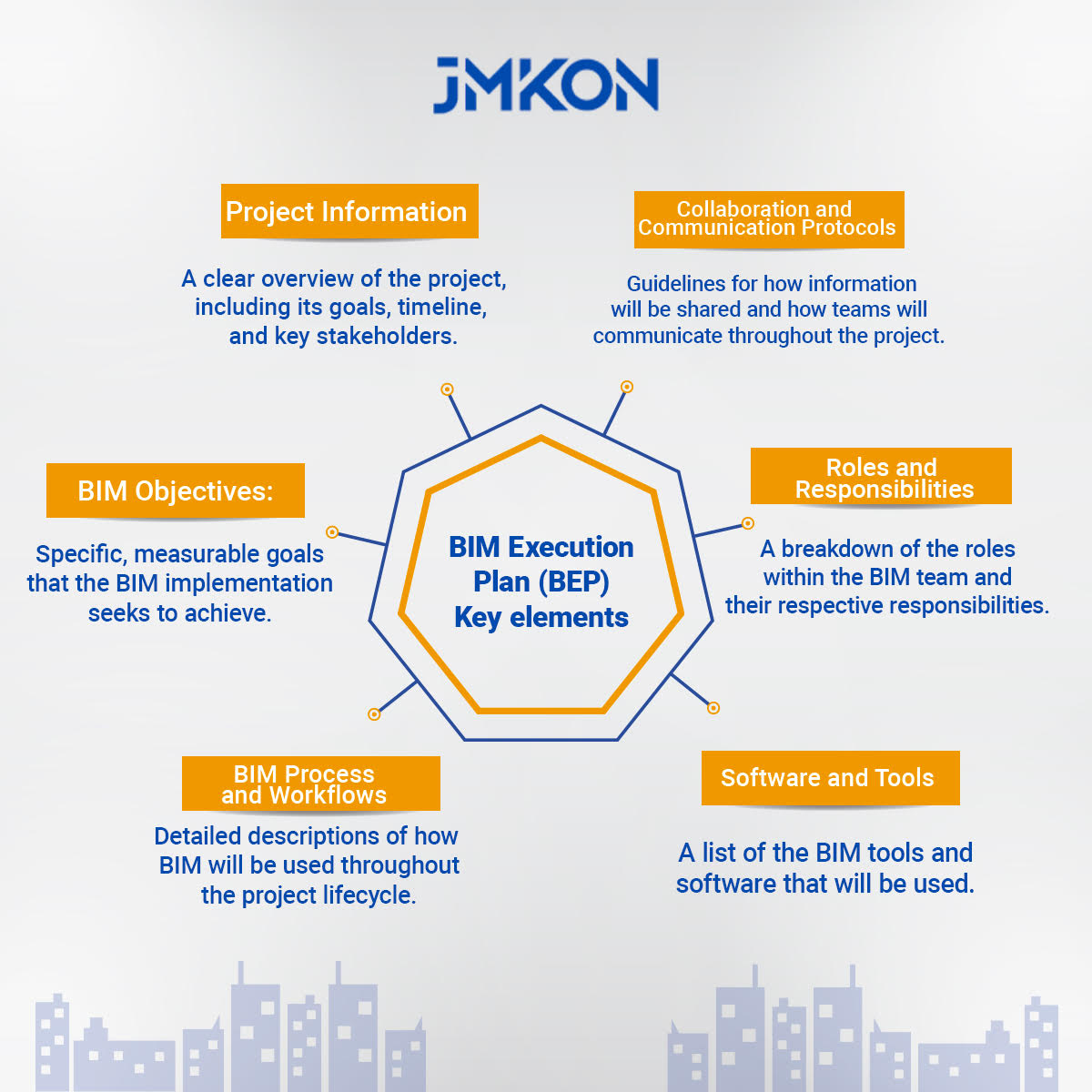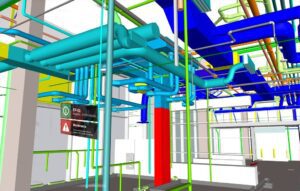Building Information Modeling (BIM) is a digital representation process used in the construction industry to create and manage information throughout a building’s life cycle. It integrates data and visuals into a comprehensive model, offering a multi-dimensional perspective of a project’s design, structure, and functional systems.
By unifying architecture, engineering, and construction (AEC) workflows, BIM enables real-time collaboration and information sharing among stakeholders, ensuring that everyone involved in the project works from the same up-to-date data.
Importance of BIM Strategy for Successful Construction Projects
- A well-structured BIM strategy helps streamline processes, avoid communication gaps, and maximize the potential of the technology.
- BIM strategy ensures that all stakeholders are aligned, helping to maintain project timelines, reduce rework, and ensure high-quality deliverables.
Understanding BIM Standards and Protocols
Ensuring Compliance with Industry Standards
One of the most important standards is ISO 19650, a global benchmark for organizing and managing information in construction projects.
ISO 19650 provides a framework for managing information in the design, construction, and operational phases of a project. It ensures that data is consistent, structured, and accessible to all stakeholders, thereby reducing risks associated with poor information management.
In addition to ISO 19650, it’s essential to familiarize your team with other relevant BIM
standards, such as the UK’s PAS 1192 series or region-specific guidelines.
Establishing clear protocols for file formats, data exchange, and collaboration workflows ensures everyone is on the same page, minimizing miscommunication and errors.
Setting Clear BIM Objectives: Defining Goals and Deliverables
Setting clear and measurable objectives is a critical step in developing a successful BIM Strategy plan. Without well-defined goals, it’s difficult to measure success or ensure that the project stays on track. When establishing your BIM objectives, consider the following:
- Project-Specific Goals: Every project is unique, and your BIM objectives should reflect its specific needs. Whether you’re looking to reduce project costs, improve collaboration, or enhance sustainability, your BIM strategy should align with the broader goals of the project.
- Deliverables: Clearly define the outputs you expect from your BIM strategy.
This could include detailed 3D models, clash detection reports, cost estimates, or a digital twin of the building. By outlining these deliverables early on, you ensure that all team members know what is expected of them and can work towards those outcomes.
- Milestones and Deadlines: Setting key milestones helps keep the project on track.
Break down the BIM strategy process into phases, such as model creation, clash detection, and 4D scheduling, and assign deadlines to each.
- Performance Metrics: Finally, define how you will measure the success of your BIM strategy. This could involve metrics such as cost savings, error reduction, or improved project timelines.
By understanding the different levels of BIM, adhering to industry standards like ISO 19650, and setting clear objectives, you can create a comprehensive BIM strategy plan that ensures project success from start to finish.
How to Develop an Effective BIM Strategy ?
- Project Scope: Larger and more complex projects may require advanced BIM capabilities, such as clash detection, 4D scheduling, or 5D cost analysis.
- Stakeholder Involvement: Determine who will need access to the BIM models and what information they will require. Engineers, architects, contractors, and clients may have different needs, so it’s important to tailor the BIM approach accordingly.
- Compliance and Regulations: Different regions and industries may have specific
- BIM standards and regulatory requirements.
Choosing the Right BIM Tools and Software
Selecting the appropriate BIM software and tools is critical to the success of your BIM strategy.
- Revit: One of the most popular BIM platforms, Revit offers robust tools for architecture, structural engineering, and construction.
- Navisworks: Ideal for large-scale construction projects, Navisworks allows for model aggregation and clash detection.
- ArchiCAD: Known for its intuitive interface and ease of use, ArchiCAD is a good choice for architectural projects.
- Other Tools: Depending on your needs, you may also consider tools like Tekla for structural modeling, Synchro for 4D scheduling, or BIM 360 for cloud-based collaboration and project management.
Defining BIM Roles and Responsibilities
Establishing a clear structure for BIM project management is essential for ensuring smooth collaboration and accountability.
- BIM Manager: The BIM Manager oversees the entire BIM process, ensuring that models are accurate, up-to-date, and comply with standards. This person is responsible for coordinating the efforts of various stakeholders and ensuring that BIM processes are followed throughout the project lifecycle.
- BIM Coordinators: BIM Coordinators work under the BIM Manager to handle specific tasks such as clash detection, model coordination, and information sharing between different teams. They are often responsible for managing the data flow and ensuring that the model is accessible to all stakeholders.
- Designers and Engineers: Designers and engineers contribute to the BIM model by developing detailed plans and specifications. Their role is crucial for ensuring the model accurately reflects the building’s design and functionality.
- Contractors and Subcontractors: Contractors use the BIM model to plan and execute construction tasks. By accessing detailed information in real-time, they can make more informed decisions on-site and reduce costly errors.
Creating a BIM Execution Plan (BEP)
The BIM Execution Plan (BEP) is a comprehensive document that outlines how BIM processes and workflows will be integrated into the project. A well-crafted BEP is essential for ensuring that all stakeholders are aligned and that the BIM strategy is executed effectively.

A BEP include:
- Project Information: A clear overview of the project, including its goals, timeline, and key stakeholders.
- BIM Objectives: Specific, measurable goals that the BIM Strategy seeks to achieve. These should be aligned with the overall project objectives, such as reducing costs, improving collaboration, or enhancing sustainability.
- BIM Process and Workflows: Detailed descriptions of how BIM will be used throughout the project lifecycle, including model creation, data exchange, and model updates. This section also outlines the processes for clash detection, design coordination, and collaboration between teams.
- Software and Tools: A list of the BIM tools and software that will be used, along with guidelines for data exchange and compatibility between different platforms.
- Roles and Responsibilities: A breakdown of the roles within the BIM team and their respective responsibilities.
- Collaboration and Communication Protocols: Guidelines for how information will be shared and how teams will communicate throughout the project. This may include protocols for data exchange, file naming conventions, and frequency of model updates.
By creating a detailed BEP, you ensure that all stakeholders are on the same page and that the BIM processes are executed efficiently from start to finish.
How to measure success of BIM Strategy
Key Performance Indicators (KPIs) for BIM Projects
Measuring the success of a BIM strategy requires the use of specific Key Performance Indicators (KPIs) that reflect project performance in critical areas. These KPIs help assess how effectively BIM is being used to meet project goals and identify areas for improvement. Key BIM-related KPIs include:
- Project Efficiency: Efficiency can be measured by tracking how long it takes teams to complete tasks and whether there are fewer delays in communication and model updates. A reduction in rework, design errors, and the time spent on model revisions can indicate increased efficiency.
- Cost Savings: BIM is designed to reduce costs through better planning, coordination, and error detection.
- Project Timelines: BIM can significantly improve project scheduling by integrating 4D modeling (time) with 3D models. By tracking how BIM has impacted project timelines, you can assess whether the project is meeting key milestones on time.
- Collaboration and Communication: A key aspect of BIM is improving collaboration between different stakeholders. Track the frequency and effectiveness of communication between teams using shared models.
Assessing the ROI of BIM
Return on Investment (ROI) is a critical metric for assessing the overall value that BIM brings to a project. Calculating BIM’s ROI involves evaluating both its financial and operational benefits.
- Financial ROI: To determine the financial return, compare the initial investment in BIM tools and training, with the savings generated through increased efficiency and reduced project costs. Key financial metrics to consider include:
○ Cost of BIM Strategy: Includes software licenses, hardware upgrades, and staff training.
○ Cost Savings: These savings can result from fewer design errors, reduced rework, shorter project timelines, and optimized material usage.
○ Long-Term Savings: Assess how BIM impacts the building’s operational phase. Improved energy efficiency, easier maintenance, and fewer repairs can lead to long-term financial benefits.
- Operational Benefits: Beyond the financial aspect, BIM provides significant operational advantages that improve project quality and stakeholder satisfaction. These operational benefits include better design quality, enhanced sustainability through material optimization, and improved facility management through detailed asset information models.
- Tracking ROI: To measure BIM’s ROI, track key project metrics such as project cost variances, time saved on rework, reduced change orders, and client satisfaction scores. Compare these metrics to similar projects that did not use BIM to get a clear picture of BIM’s added value.





